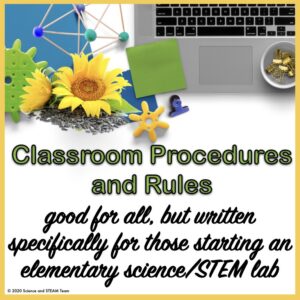As any teacher knows, the classrooms that run the most efficiently are those that have clear expectations and procedures. So, establishing classroom procedures and rules is essential! Of course, it is better for everyone if these are set at the beginning of the year.
Classroom Procedures
Classroom procedures are consistent ways of doing things.
Entering the Classroom
How do you want students to enter the classroom? What do you want them to do? When my students came into my regular classroom I greeted them individually at the door. Then, they went to their lockers, unpacked their backpacks, put down their chairs, etc. However, things are different in a lab. I still greet the incoming class at the door. I tell them exactly what I want them to do. Often, I ask them to sit on the rug, so we can have a mini-lesson. Other times, I tell them to go directly to their assigned tables. This can change depending on what is going on in the lab that day.
Getting Materials for Activities
I find it easiest to have a bin with some basic materials in it on each table. Inside each bin are sharpened regular pencils, colored pencils, crayons, scissors, glue (both liquid and stick). and tape. Materials for each group are prepared ahead of time if we are doing an experiment of STEAM activity. If appropriate, these materials are on a tray. I call on one person per group to get the materials. If the student I call on needs help, they can choose another person from their group to assist them. The key is to be prepared ahead of time so that valuable time isn’t wasted.
Many times, students have a choice of what to use during a STEM activity. Equipment and materials are placed in bins that are clearly marked, making it easy for students to find.
Cleaning Procedures
My procedure is simple. Students must put back all of their materials where they belong, place any new or ongoing projects on the back counter, and clean up any messes.
Class Dismissal Routines
My class dismissal routine is tied to the cleaning routine. Students know that the first table of students that is cleaned up and waiting quietly will the first table to line up. My table groups are numbers, so I can call out, “Table 1 may line up.”. Sometimes I call on two tables at a time, if two tables are ready simultaneously. Once lined up they wait quietly for their teacher to pick them up. Sometimes we play Science BrainQuest while waiting. What do you want your routine to look like?
With clear classroom procedures, your students will know exactly what to do.
Rules for a Science Classroom
I enjoy reading a book to my students to get them to start thinking about why rules are important. Some of the stories that I have read include: If Everybody Did, and Dinosaurs Beware. There are others.
Rules are also part of classroom procedures. I taught in several different schools and have experience with multiple grade levels and positions. As a result, I have had exposure to a few different district-wide sets of rules. The one set of rules that works the best is simple. The three rules are BE KIND, BE SAFE, and DO YOUR JOB. If a student is breaking a rule simply ask a question, “Are you being kind?”. Obviously, the question you ask depends on the rule being broken.
Each year, I ask students to brainstorm for rules that go under each category. I ask them which ones they feel are the most important. I can do this with every class. Then I post the top three to five under each category at the end of the day. For the most part, these are almost the same every year.
In a science or STEAM classroom, the area that needs special consideration is safety. This is because of the specialized equipment and materials. Generally, you will need to tell them these rules if you are just starting a lab or introducing a science area in your classroom. You can read the important safety rules in the photo below.
Consequences for Breaking the Rules
In the same way, I give students an opportunity to brainstorm for subcategories, I also ask them about consequences. This works well because they usually come up with the same list as if I would have. If you have a lab with different classes rotating through you will need to have a discussion with the classroom teacher. Will they back you on a consequence such as missing a portion of recess? Sometimes, you may have to work with the parents.
Post both the classroom rules and consequents where students see them regularly. Be consistent in following through might seem “mean” at the beginning of the school year, but it will save everyone time later. Because, if the teacher is consistent most of the students will be consistent too! Likewise, the opposite is also true.
So, what classroom procedures are you going to have in place so your classroom runs smoothly from day one? The time to start planning is now!
If you haven’t read Classroom Setup: Elementary Science Lab, you might want to do that now!
Read about what Naomi Meredith does at the beginning of the year in her STEM Classroom by reading How to Teach STEM During Back to School.
You might enjoy the following resources.
If you found this helpful, subscribe to our blog. You will get our first 5 Science Snippets for free! Each Snippet gives an everyday application of science that you can share with your students!
Be sure to come back to read our next blog about managing voice levels in the classroom.
And remember, it’s all science!







One Comment